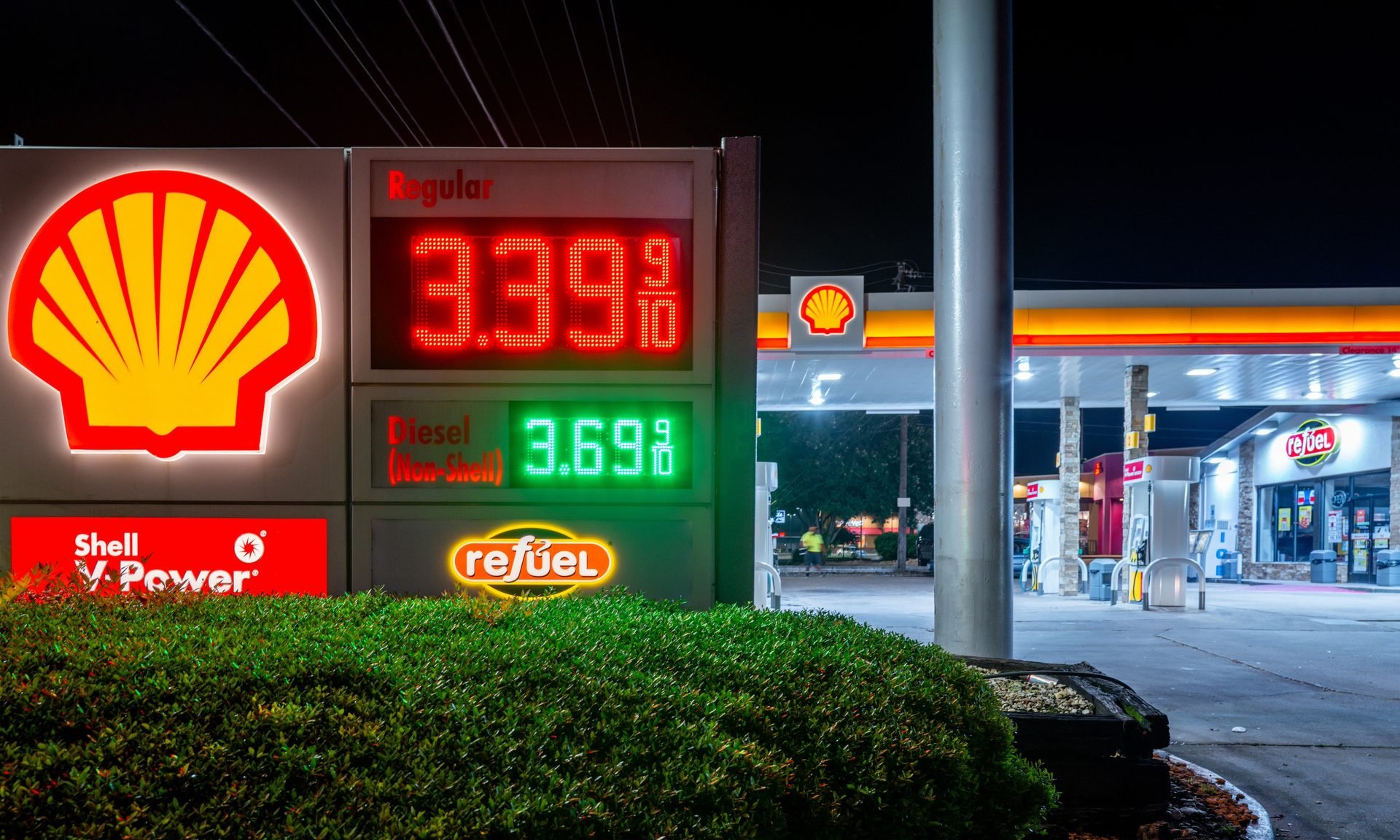Can Trump Lower Gas Prices as President?
U.S. presidents can’t control how much voters pay at the pump, but they can enact policies that encourage low fuel prices.

Many, or all, of the products featured on this page are from our advertising partners who compensate us when you take certain actions on our website or click to take an action on their website. However, this does not influence our evaluations. Our opinions are our own. Here is a list of our partners and here's how we make money.
Despite what they — and their opponents — might say, U.S. presidents don't control gas prices. Their policies might have some influence but it often takes years to materialize, says Patrick De Haan, head of petroleum analysis at GasBuddy, a gas price-tracking app.
Rather, why gas prices move up or down is better explained by supply and demand, as well as global events that affect the oil and gas supply chain.
“This is a global commodity,” De Haan said in a July 11 media call. “It’s silly to think that one president could control the price of a global commodity.”
What the president can do about gas prices
Moments after taking office for his second term, President Donald Trump signed numerous executive orders designed to “unleash” U.S. energy production. With a long list of far-reaching policies — from declaring a national energy emergency that allows him to weaken regulations to opening federal lands for more energy extraction to eliminating Biden-era standards that promoted the adoption of electric vehicles — the president hopes to expand U.S. energy dominance and lower prices for consumers.
But it turned out the most effective step Trump took to directly lower gas prices after returning to office was to enact sweeping tariffs on U.S. trade partners on April 2. The move left global markets reeling and contributed to a sudden, sharp drop in oil prices. That’s because investors feared that the tariffs would lead to a global economic slowdown that would reduce demand for oil and other energy products. So far, crude oil and other energy imports are exempt from tariffs, which could mean the higher import tax rates themselves won’t raise gas prices.
As Trump’s efforts show, a president’s policies might affect gas prices but not in a way that gives him control over how much voters pay at the pump. That doesn’t stop them from trying to lower prices. They might do that by expanding domestic oil production, withdrawing from the domestic oil reserve, changing fuel export rules or imposing (or removing) environmental regulations related to fuel.
Meet MoneyNerd, your weekly news decoder
So much news. So little time. NerdWallet's new weekly newsletter makes sense of the headlines that affect your wallet.
Here’s a look at some of the levers available to the U.S. president, the limits of that power, how it affects gas prices and recent examples of policy in action.
Expand domestic oil production
What the president can do: Open drilling on federal land. The Bureau of Land Management is responsible for reviewing permit applications for new oil drilling by private companies.
Limitations: The president can’t force private companies to produce more oil. He can only encourage it by opening access to federal land and setting other industry-friendly federal policy.
Impact on gas prices: Crude oil is the single biggest contributor to the price drivers pay for gas, according to the U.S. Energy Information Administration. Increasing the supply of oil would be one way to lower its price, which subsequently could lower the price of gas. But even if U.S. companies were interested in creating an oversupply of oil, increasing production levels in the U.S. wouldn’t be the simple solution some politicians suggest.
Oil is a global commodity that depends on global market dynamics. While the U.S. became the top-producing country in 2018, its production levels are dwarfed by the combined output of the Organization of Petroleum Exporting Countries, which makes production decisions for all its 12 members. OPEC members collectively produce the most oil and hold, by far, the largest share of oil reserves in the world, giving it the greatest influence over oil prices worldwide.
It wields that power to keep oil prices in a profitable range for its members. Since 2022, OPEC and its allies (known as OPEC+) have strategically cut oil production to offset increased oil output from the U.S., as well as decreased demand from oil importers like China. OPEC+ said it would begin to lift its production limits in May, which immediately contributed to a drop in oil prices.
Additionally, the U.S. couldn’t operate independently from those global market forces, no matter how much oil it produced. Aging U.S. refineries aren’t built to handle the quality of crude oil produced domestically, so they import lower-grade oil from other countries.
“A lot of our oil is being exported because refineries have finite capacity to refine it,” De Haan told NerdWallet in a phone interview.
Recent examples: In an executive order, Trump declared a national energy emergency, which allows his administration to use “emergency authorities” to cut through red tape and expand domestic energy production and transportation. He signed other orders that take steps to increase energy extraction projects in Alaska and expand off-shore exploration and drilling.
The number of new permits issued to companies looking to drill for oil on federal lands has been on the rise, especially under the two most recent administrations. When President Joe Biden first took office, he temporarily stopped issuing new permits. But eventually the number of permits approved by the Biden administration surpassed those issued by the Trump administration, according to news reports.
Meanwhile, domestic oil production has been largely increasing under the past three presidents.
Withdraw from the U.S. oil reserve
What the president can do: The president can authorize selling barrels of crude oil from the country’s strategic petroleum reserve, which holds up to 714 million barrels of oil in underground salt caverns along the Gulf of Mexico. The reserve can be built up and then spent down as a way to mitigate the kinds of disruptions in supply that would send gas prices soaring.
Limitations: The reserve is finite and designed for use in an emergency.
Impact on prices: It’s a move that grabs headlines but its impact on prices can be small and short-lived if the volume of oil or gas put into the market isn’t enough to make a significant or lasting impact, De Haan says.
Recent examples: In 2022, Biden authorized the sale of 180 million barrels of crude oil from the strategic petroleum reserve in an effort to offset the rise in oil prices instigated by Russia’s invasion of Ukraine. The move, which coincided with other international oil reserve releases, helped bring gas prices down by up to 40 cents, according to a U.S. Department of Treasury analysis.
“President Biden's release after oil prices surged likely cooled off the price of oil to some meaningful degree,” De Haan says. “It was a temporary impact. It's probably negligible now.”
Change import/export rules
What the president can do: Limit the amount of fuel exported by U.S. companies.
Limitations: Without access to international markets, U.S. companies might cut production of oil and gas rather than flood the domestic market with cheap fuel. That’s what happened under a ban on exports that was put in place in the 1970s. When it was eliminated in 2015 (via a budget item passed by Congressional Republicans and signed by President Barack Obama), it effectively jump-started U.S. oil production, De Haan says.
Impact on prices: The goal of this move would be to increase the local supply of oil and gas, which would pull down prices at the pump.
Recent examples: The Biden administration considered limiting fuel exports when prices were soaring in 2022, according to news reports. The idea was heavily opposed by industry groups. The administration didn’t follow through.
Change environmental regulations
What the president can do: Presidents might differ in how they use it, but they still see environmental regulations as a lever at their disposal for lowering gas prices.
On one end of the political spectrum, a president can raise fuel efficiency standards for new cars and trucks sold in the U.S. These standards are largely designed to reduce greenhouse gas emissions and encourage a shift away from gas-powered vehicles, but they can have price implications, as well.
On the other end of the spectrum, a president can deregulate oil and gas production, allowing businesses to cut costs associated with compliance.
Limitations: Any impact these policies have on gas prices would occur over the long term as the industries adapt to regulatory changes. Progress could stall if a new president takes office and changes standards once again.
Impact on prices: Regulatory changes would have different impacts, depending on the direction of the pendulum’s swing.
More fuel-efficient vehicles — including hybrid and electric vehicles — could help reduce demand for gas. Any permanent drop in demand for gas would spell big changes for the oil and gas industry, making the impact on prices hard to predict, De Haan says. Refineries might export more fuel to offset declines in domestic demand. But if demand falls far enough, it could lead oil and gas companies to close refineries. If production were to be cut too quickly, it could cause gas prices to rise.
Deregulation, on the other hand, could help to make it cheaper to produce oil and gas.
Recent examples: In March 2024, the Biden administration increased fuel efficiency standards for cars and trucks that would effectively push the auto industry to produce more electric and hybrid vehicles. Biden’s goal was to see zero-emission cars and trucks make up half of all sales by 2030. Trump immediately rolled back this policy when he took office in January.
During his first term, Trump pursued deregulation that weakened emission standards and encouraged more oil drilling on federal lands.
(Photo by Brandon Bell/Getty Images)
Article sources
NerdWallet writers are subject matter authorities who use primary,
trustworthy sources to inform their work, including peer-reviewed
studies, government websites, academic research and interviews with
industry experts. All content is fact-checked for accuracy, timeliness
and relevance. You can learn more about NerdWallet's high
standards for journalism by reading our
editorial guidelines.
Related articles













